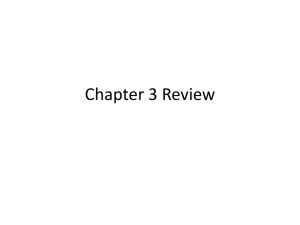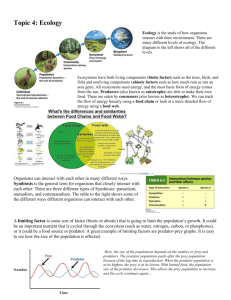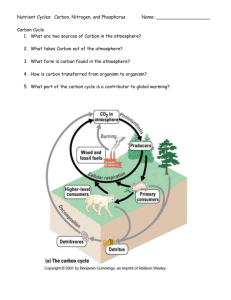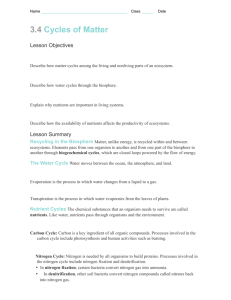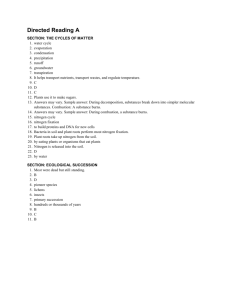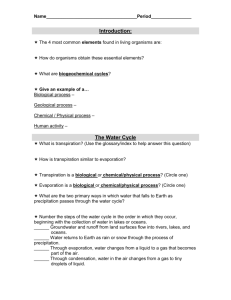3.4 Notes ws
advertisement
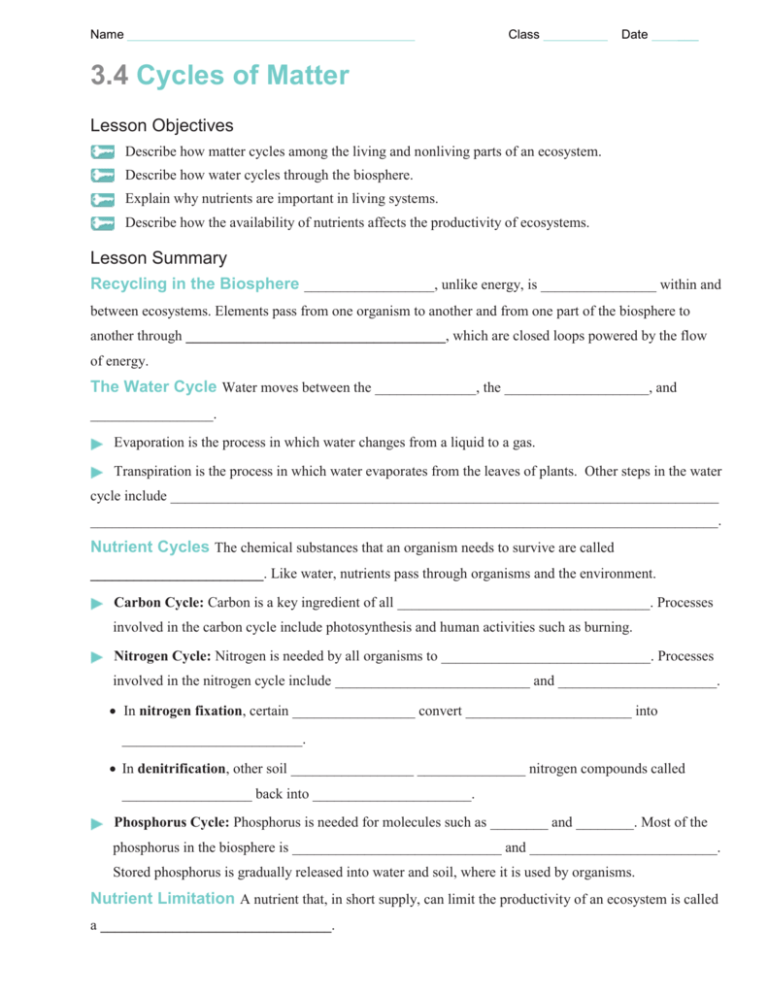
Name Class Date ___ 3.4 Cycles of Matter Lesson Objectives Describe how matter cycles among the living and nonliving parts of an ecosystem. Describe how water cycles through the biosphere. Explain why nutrients are important in living systems. Describe how the availability of nutrients affects the productivity of ecosystems. Lesson Summary Recycling in the Biosphere __________________, unlike energy, is ________________ within and between ecosystems. Elements pass from one organism to another and from one part of the biosphere to another through ____________________________________, which are closed loops powered by the flow of energy. The Water Cycle Water moves between the ______________, the ____________________, and _________________. Evaporation is the process in which water changes from a liquid to a gas. Transpiration is the process in which water evaporates from the leaves of plants. Other steps in the water cycle include ____________________________________________________________________________ _______________________________________________________________________________________. Nutrient Cycles The chemical substances that an organism needs to survive are called ________________________. Like water, nutrients pass through organisms and the environment. Carbon Cycle: Carbon is a key ingredient of all ___________________________________. Processes involved in the carbon cycle include photosynthesis and human activities such as burning. Nitrogen Cycle: Nitrogen is needed by all organisms to _____________________________. Processes involved in the nitrogen cycle include ___________________________ and ______________________. In nitrogen fixation, certain _________________ convert _______________________ into _________________________. In denitrification, other soil _________________ _______________ nitrogen compounds called __________________ back into ______________________. Phosphorus Cycle: Phosphorus is needed for molecules such as ________ and ________. Most of the phosphorus in the biosphere is _____________________________ and __________________________. Stored phosphorus is gradually released into water and soil, where it is used by organisms. Nutrient Limitation A nutrient that, in short supply, can limit the productivity of an ecosystem is called a ________________________________. Main Idea Details 1. Recycling in the biosphere 2. The water cycle 3. Nutrient cycles 4. Nutrient limitations Nutrient Cycles 5. The carbon in coal, oil, and natural gas came from A. the combustion of fossil fuels. B. the remains of dead organisms. C. carbon-fixing bacteria in swamp soil. D. carbon dioxide dissolved in ocean water. 6. How does most of the carbon in an organism’s body return to the environment after the organism dies? A. Decomposers break the body down into simpler compounds. B. Heat from the sun causes the carbon in the body to evaporate. C. Geological processes cause the body to turn into a fossil fuel. D. Rainwater dissolves the carbon in the body and carries it to the ocean. 7. Human processes mainly contribute to the A. release of carbon dioxide into the atmosphere. B. decrease of the total amount of carbon found on Earth. C. depletion of carbon dioxide reserves in the atmosphere. D. increase in the amount of carbon contained in rock materials. Fill in the blank. 8. Nitrogen, in the form of ammonia, ___________, and nitrite, is found in the soil. 9. Nitrogen fixation is the process in which certain bacteria convert nitrogen gas into _________________. 10. ______________________ is the process by which some soil bacteria convert nitrates into nitrogen gas. 11. All organisms require nitrogen to make amino acids, which in turn are used to build ________________. 12. Phosphate is released as ______________________________ wear down. 13. Plants absorb phosphate from the _____________ or from water. 14. ______________________ is the most abundant gas in the atmosphere. 15. __________________ is taken up by producers during photosynthesis and released by cellular respiration. 16. _____________________ forms part of the important life-sustaining molecules such as DNA and RNA. 17. Plants absorb phosphorus from _____________ or water. 18. List and describe the biological steps in the nitrogen cycle. 19. What is atmospheric nitrogen fixation, and how does it affect organisms? 20. How do humans add nitrogen to the biosphere? 21. Which parts of the phosphorus cycle are geological processes? Nutrient Limitation 22. If a nutrient were in short supply in an ecosystem, how might it affect an organism? 23. When is a substance a limiting nutrient?

